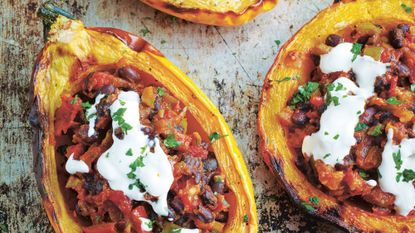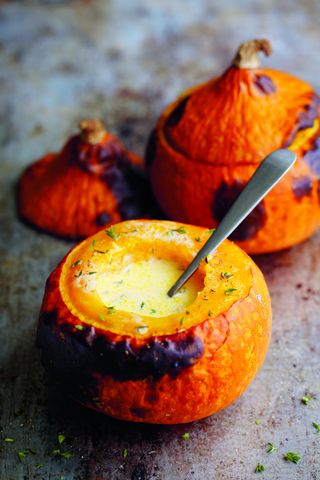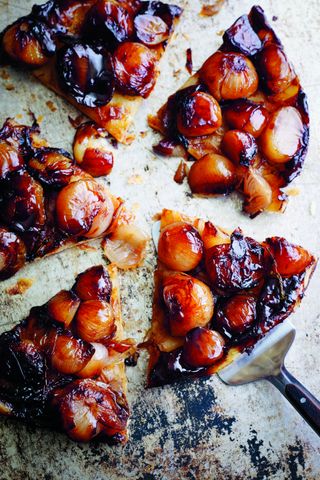5 delicious organic winter recipes from Riverford
Some quick and easy vegetable recipes for foodies in need of some weekend warmth and goodness…

Some quick and easy vegetable recipes for foodies in need of some weekend warmth and goodness…
With the cold months upon us, we're looking to Riverford Organics to see us through the winter, raiding their Riverford Companion cook book: autumn & winter veg for our favourite veg-based recipes.
Here are our top picks...

1. SQUASHY BOTTOM SOUP BOWLS
This easy-to-make squash soup doesn’t even require any bowls – just eat it straight out of the shell, saving on the washing up and adding to the entertainment. It’s a great child-pleaser for Hallowe’en and has endless variations with different garnishes – some fried shiitake or chestnut mushrooms would up the earthy autumnal feel.
SERVES 4
4 small squash (onion squash is ideal) 300g Ogleshield cheese (or a good melting cheese such as Gruyère or Cheddar), grated 100g Parmesan (or vegetarian equivalent), grated about 40g butter few gratings of nutmeg 4 small thyme sprigs 800ml double cream salt and black pepper
Marie Claire Newsletter
Celebrity news, beauty, fashion advice, and fascinating features, delivered straight to your inbox!
Heat the oven to 190°C/Gas 5.
Slice the tops off the squash and scoop out the seeds and pulp, then place the squash bowls, cut-side up on a baking tray (reserve the lids).
Divide the cheeses and butter between the squash and add a grating of nutmeg and a small sprig of thyme to each, then pour in the cream to two thirds of the way up each squash bowl.
Season with generous amounts of black pepper and a cautious amount of salt – bear in mind the saltiness of the cheeses. Put the lids on, place on a baking tray and bake for 45 minutes to 1 hour, depending on the size of your squash, until tender. Eat by scraping the soft flesh into the hot cream.
Variations: Serve this in a large single squash, such as a crown prince. Treat it like a large fondue pot, dipping in toast soldiers or leftover roast potatoes. You will need to up the cooking time – this will take at least 1 hour, and it’s worth reducing the oven temperature to 180°C/Gas 4 and/or wrapping the squash loosely with foil so the outside doesn’t brown too much before it cooks through. The flesh should give to the tip of a knife.

2. PARSNIP, BRUSSELS SPROUT & BACON POTATO CAKES
This is a jazzed-up version of bubble and squeak and can be adapted to finish up all sorts of leftover vegetables, though parsnips, sprouts and bacon is a particularly satisfying combination. A poached or fried egg or sausages would be a good addition.
SERVES 4
200g parsnips, peeled & cut into even-sized pieces (alternatively, you could use leftover boiled, steamed or roasted parsnips) 3 tbsp olive oil 300–400g potatoes, peeled & cut into even-sized pieces 200g Brussels sprouts, outer leaves removed 8 rashers smoked streaky bacon, finely sliced polenta flour (or use ordinary plain flour), for dusting salt and black pepper
Heat the oven to 200°C/Gas 6. Toss the parsnips with salt, pepper and about a tablespoon of the oil. Spread over an oven tray and roast for about 40 minutes, until soft and beginning to caramelise. Remove, allow to cool then roughly chop.
While the parsnips are roasting, boil the potatoes in salted water until soft, about 20 minutes. Drain well and mash while warm. Keep your mash as dry as possible so that the cakes hold together; if it seems wet stir it over a low heat for a few minutes.
Cook the sprouts in plenty of salted boiling water until tender, about 5 minutes. Drain well and cut into quarters. Fry the bacon over a medium–high heat with a drizzle of oil in a large frying pan (preferably non-stick) until really crispy. Remove with a slotted spoon and drain on kitchen paper. Keep the oil left in the pan to fry the cakes.
Mix all the veg with the bacon and season with salt and pepper. Dust your hands with flour then mould the mixture into burgersized patties.
Add the remaining oil to the frying pan, place over a medium heat and fry the cakes in batches until they are golden brown, about 5 minutes per side. Add more oil to the pan if you need it. If the first cakes have cooled down by the time you have fried the last, you can reheat them all in the oven for 5–10 minutes, until piping hot.
Variations: * Replace the parsnips with roasted beetroot or squash for striking coloured alternatives. * Use raw grated apples instead of bacon for a vegetarian option. * Experiment with your greens: try cabbage or kale.

3. SHALLOT TARTE TATIN
A savoury twist on the classic French apple tart, this makes an excellent lunch or supper with a simple green salad and some good sharp cheese (goat’s or other). If you don’t have the right sized ovenproof frying pan, transfer the cooked shallots to a small greased pie dish or shallow cake tin before topping with the pastry.
SERVES 4
50g butter 500g shallots, peeled 120ml good-quality balsamic vinegar small bunch of thyme, tied together tightly with string 1 x 300g ready-rolled sheet all-butter puff pastry salt and black pepper
Heat the oven to 200°C/Gas 6.
Heat the butter in a heavy-bottomed ovenproof frying pan (beware wooden and plastic handles!). The shallots will shrink a lot, so the pan might need to be smaller than you’d imagine. Add the shallots and cook on a medium heat until they start to brown, turning occasionally, about 8 minutes.
Add the balsamic vinegar, thyme, a teaspoon of salt, some pepper and enough water to cover. Poach the shallots until they are cooked through and completely soft, about 10 minutes, adding more water if necessary.
Remove the thyme, then bubble the liquid and reduce it until the balsamic vinegar becomes syrupy. Remove from the heat and check the seasoning.
Cut a circle of pastry a little larger than the pan, then lay it over the shallots and quickly tuck down the sides (without burning your fingers). Cut a small slit in the centre for a steam vent.
Immediately place the pan in the oven and bake for 20–30 minutes until the pastry is puffed and golden. Leave to cool for 5 minutes, and then invert on to a large flat plate or wooden board, cut into wedges and serve warm.

4. LEEK AND SMOKED CHEESE MACARONI
An invigorating winter dinner, this goes well with salad or a generous helping of wilted greens. Make more than you need, as this freezes well either before or after it is baked.
SERVES 4
400g macaroni drizzle of olive oil 40g butter 4 small leeks (about 400g), washed and shredded 4 heaped tbsp plain flour 800ml milk 200g smoked Cheddar, grated, plus extra for topping 2 tsp Dijon mustard, or to taste 4 tbsp breadcrumbs (optional) salt and pepper
Heat the oven to 200°C/Gas 6.
Boil the macaroni in a pan of salted water until nearly cooked, about 8 minutes. It should be slightly too al dente to eat. Drain and toss in a little olive oil to stop it sticking together.
While the pasta is cooking, melt the butter in a small pan on a low heat. Add the leeks and cook gently until soft, about 7 minutes, stirring now and then.
Add the flour and stir over a low heat for 2 minutes, then gradually stir in the milk (a whisk helps avoid lumps). Add the cheese and heat gently, stirring, to thicken the sauce and melt the cheese. Season to taste with mustard, salt and pepper.
Combine the pasta with the leek mixture and transfer to a baking dish. Sprinkle over a little more cheese and the breadcrumbs, if using, and bake for about 20 minutes, until golden on top.
Variations: * Add some leftover cooked chicken or fried bacon pieces to the leek mixture before baking. * For extra veg, stir through some blanched and chopped kale, cabbage, spinach, chard or broccoli.

5. BEETROOT & PINK PEPPERCORN GRATIN
Comforting and colourful, this hearty gratin gets its mild warmth and fruity, spiced edge from the pink peppercorns. A food processor or mandolin will make quick work of the prep, otherwise settle down with a very sharp knife.
SERVES 6 (as a side)
2 large garlic cloves, peeled 400ml double cream 800g beetroot, peeled & cut into 2mm slices 175g sourdough bread, sliced (best if slightly stale) 20g cold butter, diced 1 tsp sunflower, rapeseed or olive oil 1 tbsp pink peppercorns, finely ground 1 tbsp red wine vinegar salt & black pepper
Heat the oven to 180°C/Gas 4.
Lightly crush the garlic cloves with the flat of a knife and put them into a small pan with the cream. Slowly bring to a simmer and cook for 10 minutes.
Strain the cream through a sieve, pressing the garlic with the back of a spoon to extract its flavour. Season generously with salt and mix well.
Pack the beetroot flat into a roasting dish and pour over the cream. Cover tightly with foil and bake for about 1 hour, until the beetroot is just tender.
Meanwhile, pulse the bread in a food processor or blender until reduced to coarse crumbs. Add the butter and oil and pulse again until the butter is evenly distributed.
Remove the foil from the roasting dish, then stir in the ground peppercorns and red wine vinegar. Taste and adjust the seasoning if necessary. Cover with the breadcrumbs and return to the oven for 25 minutes or so, until golden brown on top.
Variations: * Instead of the peppercorns and vinegar, add a little freshly grated horseradish or a spoonful from a jar. * Stir in some fresh or dried herbs, such as thyme, sage or finely chopped rosemary. * Replace half the beetroot with potato or another root veg.
Visit the Riverford site for more information
The leading destination for fashion, beauty, shopping and finger-on-the-pulse views on the latest issues. Marie Claire's travel content helps you delight in discovering new destinations around the globe, offering a unique – and sometimes unchartered – travel experience. From new hotel openings to the destinations tipped to take over our travel calendars, this iconic name has it covered.
-
 Emily in Paris' Lucien Laviscount is reported to be dating a very A-list singer
Emily in Paris' Lucien Laviscount is reported to be dating a very A-list singerBy Jenny Proudfoot
-
 Can you build muscle with bodyweight exercises? Here's what top PTs had to say
Can you build muscle with bodyweight exercises? Here's what top PTs had to saySpoiler alert: you can, but there are a few caveats.
By Rebecca Shepherd
-
 Not even I, as a beauty editor, can resist the temptation of 50% off at Cult Beauty - here are the 12 products I will be shopping
Not even I, as a beauty editor, can resist the temptation of 50% off at Cult Beauty - here are the 12 products I will be shoppingBy Katie Thomas